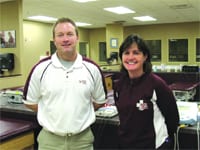Head Strong More Than Ever, Athletes with Concussions Are Playing It Smart
Every year, in the weeks leading up to its Sportsman of the Year issue, dozens of writers for Sports Illustrated pen short essays nominating someone for the award. Last month, football scribe Peter King nominated Kurt Warner, who played exactly two games in 2010. Why? More than anything else, for being honest with himself and walking away from the game.
King thought about the game in 2009 when the Cardinals quarterback suffered a concussion against St. Louis. A week later, he was mostly asymptomatic, but was still sensitive to light and suffered from a neckache — mild symptoms, to be sure, of the sort that athletes are often conditioned to shake off. He thought about whether to share these things with the team doctor, or simply ignore them and get back on the field.
“I thought about it, and I had to say to myself, ’What are you doing? What are you thinking?’” Warner told King. “I have seven kids, a wife. A life. I want to win as much as anyone. But at the end of the day, you have to be able to take a step back and realize what you’re talking about. It’s a football game, versus the rest of your life. You wonder if your teammates are thinking, ’yeah, he wimped out on us. Yeah, he wasn’t tough enough. Yeah, he wouldn’t come to battle with us.’ But I had to do what was right for me.”
Warner sat against Tennessee the following week, and his team lost. And when the season ended, one game after his brilliant, 29-for-33, 379-yard, five-touchdown day against Green Bay in the playoffs, he had no reservations about retiring. He knew what one more serious blow to the head could do.
More than ever before, athletes on every level, from high school through college and the professional ranks, are realizing the same thing, as coaches, trainers, and — in Massachusetts’ case — state law are hammering home the seriousness of concussions and other head traumas.
The issue has become a high-profile one, with the NFL issuing heavier and more frequent fines than ever before for helmet-to-helmet hits. Chris Nowinski, a former professional wrestler who co-founded the Sports Legacy Institute and wrote the book Head Games to bring attention to the long-term effects of repeated sports concussions, is yet another nominee for SI’s Sportsman of the Year, further reflecting the ever-brighter spotlight being shined on this topic.
People like Nowinski — who has documented permanent brain damage in NFL players and is unapologetically among the league’s harshest critics — understand that, while the initial effects of these injuries may not be avoidable (more on that later), the long-term effect can be devastating, especially when returning to play too soon.
“A concussion is basically a term for brain injury,” said Dr. Julio Martinez-Silvestrini, a sports medicine specialist and medical director of Baystate Rehabilitation Care. “We know that chronic headaches, mood changes, depression, and even dementia may be caused by repeated trauma to the brain.”
Concussions are prevalent in any number of sports — football, soccer, wrestling, and ice hockey are among the most common — but they’re often misunderstood, said Dr. Zachary Marowitz, a neuropsychologist at Baystate Medical Center, who recently launched a head-injury clinic with Martinez-Silvestrini. He said one of the most common myths is that a concussion occurs only when an athlete is hit on the head and loses consciousness.
“That’s not true,” he told the Healthcare News. “It has more to do with the forces impacting the brain — the acceleration and deceleration forces — that cause shear injuries or, in many cases, what turns out to be metabolic changes in the brain” — changes, he noted, that don’t show up on CT or MRI scans, so they can be difficult to track.
This sort of damage can occur whether or not an athlete, or someone who has been in an accident, blacks out. The medical community estimates that 300,000 sports injuries per year involve loss of consciousness, but that happens in only about 10{06cf2b9696b159f874511d23dbc893eb1ac83014175ed30550cfff22781411e5} of concussion-related incidents, putting the actual number of sports-related concussions around 3 million.
This is the number that concerns doctors most, even though it doesn’t include accident- and fall-related concussions. The reason is that it’s unlikely that, say, a car-crash victim will go out and get into another accident right away — but athletes are continually urged to get back on the playing field, subjecting their brains to further impacts, before the initial concussion has healed. And that’s where the real danger begins.
In this issue, the Healthcare News examines why repeated concussions, particularly when previous head traumas have not yet healed, can be devastating and occasionally fatal, why doctors and trainers now have the law on their side in keeping injured players off the field, and why following that law is only a starting point in making sure athletes don’t shorten their lives in the pursuit, as Warner put it, of not wimping out.
Damage Control
It’s called “An Act Relative to Safety Regulations for School Athletic Programs.”
The bill that passed both houses on Beacon Hill and was signed into law by Gov. Deval Patrick this past summer mandates that any student who suffers from a concussion cannot resume sports activities until cleared by a physician, neuropsychologist, certified athletic trainer, or other licensed health care professional. The law also calls for the creation of a statewide head-injury safety training program in which public schools must participate.
Gordon Johnson, a Wisconsin attorney who writes the Brain Injury Blog (www.tbilaw.com), praises certain aspects of the Massachusetts law — particularly the development of the safety programs — but argues that it has a massive flaw: the fact that it specifically calls for athletes to be pulled from play if they lose consciousness, which he believes could create a loophole in dealing with the other 90{06cf2b9696b159f874511d23dbc893eb1ac83014175ed30550cfff22781411e5} of concussions.
“The law creates a bright-line rule that there is no return to play if the athlete is knocked out. But if there is no loss of consciousness, then the athlete is only kept out of the same game if ’a medical professional’ makes the diagnosis of concussion,” Johnson notes. “This is inadequate to provide the protection necessary. Until all scholastic athletic programs are attended by team physicians competent to make a concussion diagnosis, this invariably means that coaches and players will have an excuse to allow a return to play.
“It is not possible,” he continues, “to tell the difference between the insignificant concussion and the significant concussion until, at a minimum, hours after the event. The best way to determine concussion severity is amnesia, which may not become apparent for hours or days afterwards. If we can’t distinguish between the severe and the mild concussion, we must err on the side of safety and hold out all concussed athletes.”
That’s an especially important matter for younger athletes — there’s some debate over whether the most-at-risk group is under 20 or under 24 — who return to sports before a concussion is resolved, because they’re in danger of what’s known as second-impact syndrome of they sustain another one.
“It’s a cascade impact in the brain,” said Susan Guyer, associate professor of Exercise Science and Sports Studies at Springfield College. “The brain can bleed, causing brain damage or loss of life.” With older athletes, that’s not as grave a concern, but they’re still susceptible to serious brain changes caused by multiple concussions.
The protocol Springfield College has in place, and one Guyer would like all high schools and colleges to eventually follow, involves performing a battery of neurocognitive testing, including a computerized assessment, on every athlete at the start of the season, measuring baseline scores for memory, reaction time, impulse control, ability to follow directions, and other behaviors.
When an SC player is suspected of sustaining a concussion during practice or competition, he or she is removed from activity and evaluated by a trainer. If a concussion diagnosis is made, the athlete is transported to Mercy Medical Center by ambulance to be seen by a doctor.
“Typically, coaches are trained to notice symptoms of concussion,” said Barclay Dugger, coordinator of Athletic Training Services and head athletic trainer at the college. “They see the mechanics of the athlete on the field, and they’re taught to recognize the confusion, lethargy, the athlete not acting normal, personality changes. If they pick up on these things, the athlete is immediately disqualified and put into the concussion-management program.”
But that’s just the beginning. “When they’re symptom-free, they retake the neurocognitive test, and they have to return to the baseline,” Guyer said. Once those scores have returned to normal and the student also passes a balance test, and is cleared for play by the campus medical director, the college insists on a four-step, gradual return process that’s commonly used at other schools.
On the first day, the athlete exercises for 30 minutes in an activity, such as biking or running, in which they elevate their heart rate and break a sweat. If symptoms don’t return, they can return to sport-specific (but non-contact) activities on the second day. On the third day, again barring the return of symptoms, they may return to full practice status, followed by game participation on day four. “If there are any symptoms at any point,” Dugger said, “they’re referred back to the team physician, and the process is started all over again from scratch.”
Further rules are in place for a second concussion during a season, which requires a longer disqualification from competition following the resolution of symptoms — and a third concussion, which is typically a season-ending injury.
Many high schools that use such a system — including Holyoke High School — modify it so that each of the four steps takes two days, for a minimum total of eight days, reflecting the greater care taken with younger athletes who are more susceptible to second-impact syndrome.
While the human factor of these assessments is important, Guyer said, athletes tend to be more honest with the computer. “They might say, ’I’m good, I’m good,’ but they get on the computer and see the symptoms, and they say, ’you know what? I do have that.’”
Other, similar initiatives have taken hold in Massachusetts, such as the ImPACT program operated out of Berkshire Medical Center in the westernmost region of the state. The acronym stands for Immediate Post-concussion Assessment and Cognitive Training, and it also uses preseason baseline assessments to help coaches and trainers in the region determine whether a player might have brain injury, even when the outward signs aren’t obvious.
They Add Up
But it’s not just concussions that concern doctors and athletic trainers. Participation in contact sports over a long period of time may cause permanent changes to the brain due to accumulated ’microtraumas’ caused by that constant acceleration and deceleration.
Consider the case of Owen Thomas. He was a talented and well-liked defensive lineman for Penn — a team captain, in fact — who took his own life this year at age 21. The cause appears to have been chronic traumatic encephalopathy (CTE), a disease that has been linked to depression and impulse control, mostly among professional football players.
Nowinski, the Head Games author, brought CTE to greater prominence by documenting its impact on late NFL veterans like Mike Webster, Terry Long, and Andre Waters, but Thomas’ case was different, and perhaps more disturbing, as he was much younger when the disease became evident.
Thomas didn’t have any history of depression and had never been diagnosed with a concussion or showed any symptoms normally associated with brain injury, and evidence suggests that his condition might have been the result of thousands of small hits building up over time.
“This can happen to athletes in contact sports, like football, boxing, and ice hockey,” Dugger said. “They may not suffer a concussive episode, but the microtraumas sustained from 150 hits in practice and in games, accumulating over 10 to 15 years, starts the process of the brain developing encephalopathy or a host of other debilitating brain diseases. It’s not always one concussive episode.”
The National Athletic Trainers’ Assoc., he explained, is starting to put sensors in helmets to determine how many traumatic events athletes are sustaining during practice and games, and debating whether to cap the number of episodes. That might include calls to decrease the number of full-contact practices per week to reduce the number of microtraumas athletes accumulate over their high-school and college careers.
“Every game, they’re smashing into each other, and they may not have overt concussions, but thousands of impacts,” Marowitz said of football linemen and, to a lesser extent, athletes in other contact sports. “Baseball players have pitch counts to protect their shoulder; well, a head is more important than a shoulder.”
Athletes in certain sports will always be exposed to the risk of concussion, he continued. “The biggest thing, from my perspective, is what you do after the concussion, how you identify it quickly and manage it afterward.
“Helmets were meant to prevent skull fractures,” he explained. “It’s like an airbag, which is great at keeping you from smashing your face but won’t keep you from a concussion. When you go from 65 to zero, your brain’s still going 65 until it hits the front of your skull.”
Guyer agreed. “The nature of football is that the brain is going to move within the cranium regardless of the helmet,” she said. “You’ll have acceleration and deceleration, and the trauma happens regardless of the helmet. So I don’t know the answer to making sports safer. You can have stricter rule enforcement, like what the NFL is doing by cracking down on helmet-to-helmet hits, and making sure you have individuals who respect each other on the field.”
That involves a culture change, but Dugger is optimistic that such a shift in thinking is possible, considering how seriously various sports organizations are taking head trauma, and the growing awareness of the issue by athletes at all levels.
“Down the road, you’ll see a lot of improvement in technique,” he told HCN. “The younger generation is now getting all this new information, and athletes and coaches will only increase the awareness. Our current athletes and coaches aren’t all trained in this, but 10 years from now, it’ll be second nature.”
Hopefully, that will prevent more stories like that of Owen Thomas, or of NFL players fighting chronic depression, early dementia, and suicidal impulses in their 40s.
Kurt Warner understands this better than most. “I don’t think about one more game defining me,” he told Sports Illustrated. “I’m thinking about the 50 years with my family after this part of my life.”



